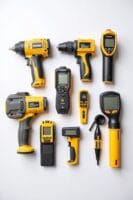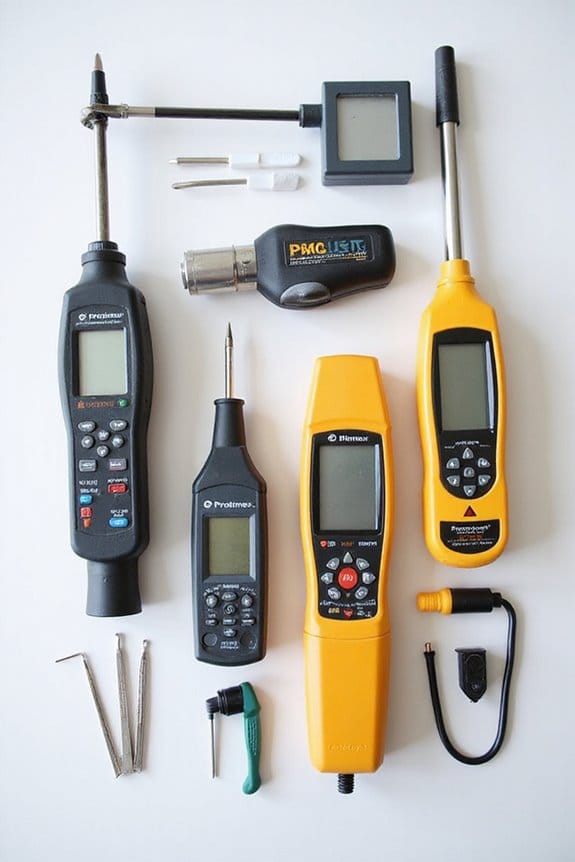When it comes to moisture meters, it really boils down to what you need. Pin meters give accurate, deep readings and are great for wood, but they do leave holes. On the other hand, pinless meters scan surfaces quickly and without damage—perfect for finished floors! I’ve found most pros lean towards pinless for speed, but if you’re after precision, pin meters are your best bet. Stick around, and I’ll share more tips to help you choose the perfect meter!
Key Takeaways
- Pin moisture meters provide accurate, quantitative readings but leave tiny holes and require calibration for reliability.
- Pinless moisture meters scan surfaces without damage, offering quick readings but may lack precision on uneven surfaces.
- Pin meters are ideal for deep, precise measurements in wood and porous materials, while pinless meters excel in speed and convenience.
- Cost-wise, pin meters are cheaper, but pinless meters may offer long-term savings due to durability and reduced replacement frequency.
- User preferences vary: home inspectors favor pin meters for accuracy, whereas construction professionals often choose pinless meters for speed and non-invasiveness.
Understanding Pin Moisture Meters

When it comes to measuring moisture in materials, pin moisture meters are like your trusty sidekick—always ready to lend a hand when you need precise data. Here’s why I think they’re fantastic:
- Pin Functionality: By inserting two metal pins into the material, they measure electrical resistance. More moisture equals less resistance, giving you a percentage for moisture measurement.
- Accuracy: They provide direct readings from inside the material. You can even check moisture levels at different depths, which is super handy.
- Practical Use: Whether you’re inspecting wood for flooring or checking subfloors, these meters pinpoint exactly where moisture lurks.
Just remember, while they’re accurate, they do leave tiny holes. But hey, that’s a small price to pay for precise data! Additionally, regular calibration checks are essential for maintaining reliable measurements, ensuring you get the most accurate readings possible.
Understanding Pinless Moisture Meters
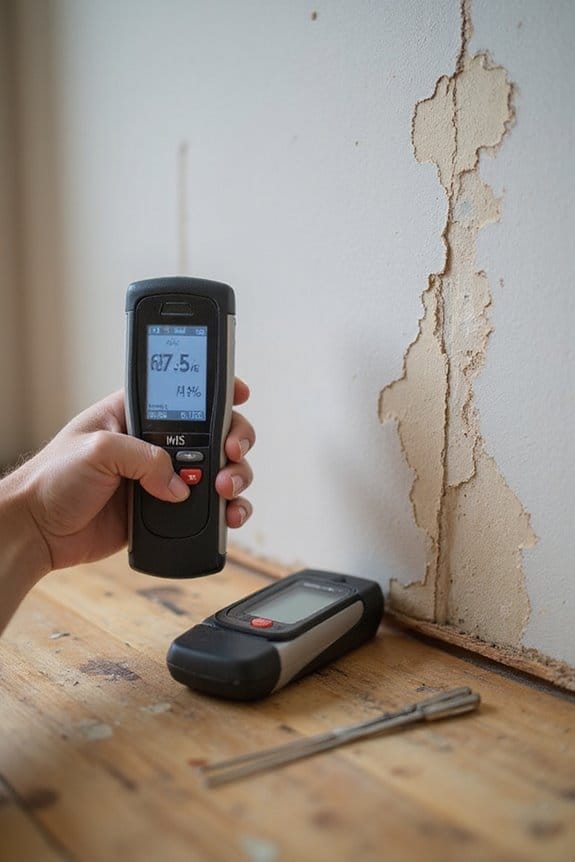
Pin moisture meters are great for precise measurements, but pinless moisture meters offer a whole different approach. Here’s what you need to know about them:
- Measurement Techniques: Pinless meters use electromagnetic sensor technology. They scan wood surfaces without penetrating them, emitting radio waves that measure moisture up to 1.5 inches deep.
- Speedy Results: You get quick readings—often in seconds—making them perfect for larger areas like floors or furniture.
- Non-Damaging: Since they don’t use pins, you won’t end up with a bunch of holes in your materials.
- Ideal Use: They’re great for initial assessments but might require a pin meter for precise moisture content. Additionally, regular monitoring helps protect property value and integrity, making moisture meters vital for home maintenance and inspection.
In short, pinless meters are efficient and user-friendly tools for moisture detection!
Accuracy and Precision Comparison
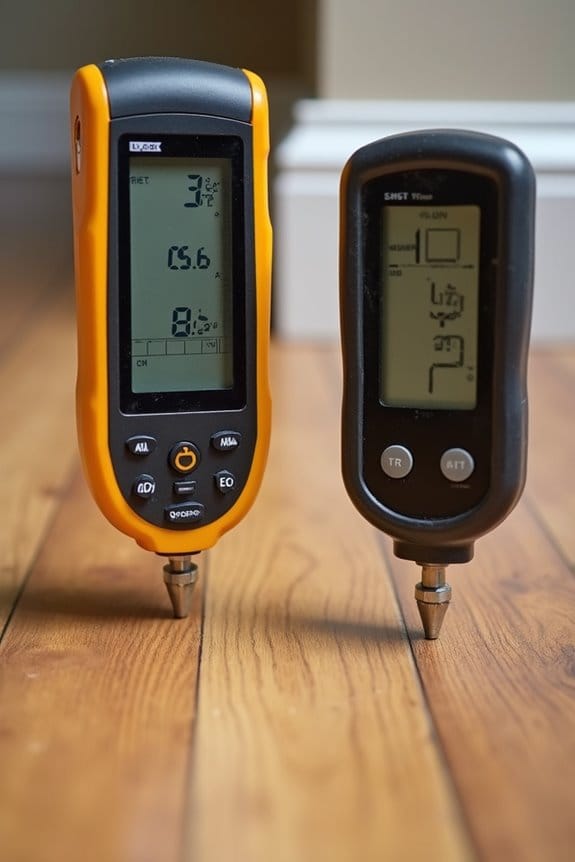
While both pin and pinless moisture meters have their strengths, understanding their accuracy and precision can help you choose the right one for your needs.
- Pin Meters: They measure moisture directly by inserting probes. This gives you accurate, quantitative readings. However, precision challenges arise with different wood species, as their resistance can vary.
- Pinless Meters: These use electromagnetic signals and scan surfaces without penetration. While they’re great for quick checks, you might face accuracy considerations if the surface isn’t smooth or if moisture levels are high, leading to erratic readings. Additionally, non-invasive technology in pinless meters ensures that surfaces remain undamaged during checks.
In short, if you need deep, precise measurements, pin meters are your best bet. But if you’re after speed and broad area scans, pinless might be your go-to.
Speed and Convenience of Use
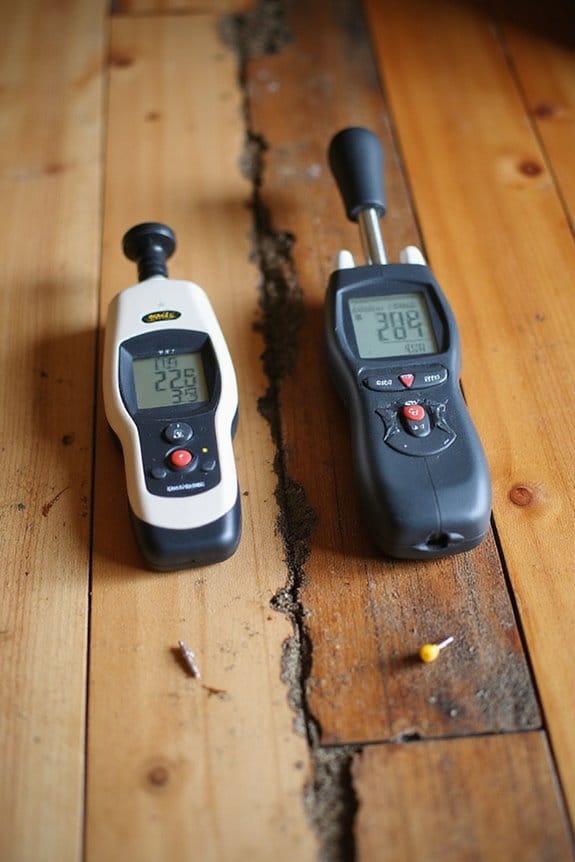
If you’re looking for a moisture meter that saves time and hassle, you might want to contemplate the advantages of pinless models. Here’s why they stand out regarding speed and convenience:
- Quick Readings: Pinless meters scan large areas in seconds, while pin meters need multiple punctures for thoroughness. Talk about a time-saver!
- User Convenience: No surface damage means you can continuously scan without worrying about pesky entry points. It’s as easy as swiping!
- Less Effort: With no pins to insert, you’ll find pinless meters require considerably less physical effort and prep work.
In a nutshell, if you’re after speed efficiency and user convenience, pinless meters are my go-to choice for moisture detection. They make life a whole lot easier! Additionally, pinless meters utilize electromagnetic fields for non-damaging scans, which is perfect for larger areas like walls and masonry.
Application Suitability for Different Projects
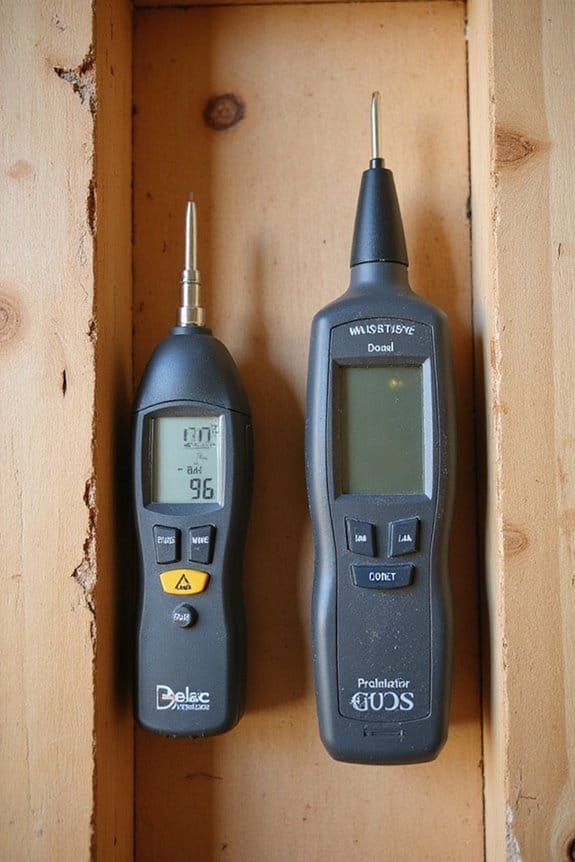
When it comes to choosing the right moisture meter for your project, understanding application suitability is key. Here’s a quick breakdown:
- Pin Meters: Great for layered materials or deep moisture detection; they measure moisture below the surface, making them ideal for wood and porous materials. If you need precise readings in a small area, go for these.
- Pinless Meters: Perfect for rapid assessments over large areas, especially on non-porous surfaces. They’re handy in tight spots and won’t damage finished materials.
To decide, always conduct a project requirements analysis. Consider your moisture detection methods and the materials involved. It’s like choosing between a precision tool and a speedy scanner—each has its time to shine! Additionally, understanding non-destructive testing capabilities can help you choose a meter that minimizes damage to surfaces while providing reliable readings.
Damage and Invasiveness of Testing
Choosing the right moisture meter isn’t just about functionality; it’s also about understanding how damaging each type can be during testing. Here’s a quick rundown:
- Pin-Type Meters: These guys create physical puncture marks. While the damage is usually minimal, repeated testing adds up. They’re invasive, which isn’t great for delicate surfaces.
- Pinless Meters: On the flip side, these meters don’t cause any surface damage. They use electromagnetic sensors that keep your surfaces intact and looking good. Plus, you can test the same area multiple times without worrying about degradation.
In my experience, if you’re working with finished or sensitive materials, pinless is the way to go. After all, who wants to explain puncture marks on a beautiful wooden table?
Cost Considerations for Professionals
Cost considerations for moisture meters can be a bit overwhelming, especially when you’re trying to balance quality and budget. Here’s what I’ve learned:
- Initial Costs: Pin meters can be quite affordable, ranging from $25 to $50, while pinless models start at over $100.
- Long-Term Savings: Pinless meters often outlast their pin counterparts, saving you money on replacements due to wear and tear.
- Cost Efficiency: Investing in a higher-priced meter can reduce indirect costs from inaccurate readings, which can lead to time lost and further damage.
- Accuracy: Remember, cheaper meters may save you upfront but can cost you more in the long run if they lead to misdiagnosis.
In the end, a quality meter pays for itself!
Combining Both Meters for Comprehensive Assessment
While many might think you can rely solely on one type of moisture meter for inspections, combining both pin and pinless models can truly enhance your assessment capabilities. Here’s why I recommend using both:
- Efficiency: Pinless meters quickly scan large areas, spotting potential moisture issues without damage.
- Precision: Pin meters drill down for exact moisture readings, perfect for confirming problem spots.
- Cross-Referencing: Combining measurements from both gives a thorough assessment, validating findings and reducing errors.
- Non-Destructive Testing: Pinless meters protect surfaces, while pin meters do the heavy lifting when needed.
Using both types not only optimizes inspection time but also boosts your confidence in the results. Trust me, the dual meter benefits are worth it for anyone serious about moisture management!
Industry Preferences and Trends
As industries evolve, it’s fascinating to see how preferences for moisture meters shift based on specific needs and trends. Here’s what I’ve noticed:
- Home Inspectors: They usually prefer pin meters for accuracy on wood and porous materials.
- Construction Pros: They often favor pinless meters for quick and non-invasive surface scanning.
- Flooring Contractors: Pinless meters rule here—no one wants to damage a finished floor!
- Technology Trends: There’s a growing reliance on pinless meters for their speed, but pin meters still shine when precision is key.
Making the Right Choice for Your Needs
How do you decide which moisture meter is right for your needs? First, consider your application. Here are three key points to help you:
- Measurement Accuracy: If you’re after precise moisture content, go for a pin meter. It’s all about those accurate readings! Pinless meters are great for quick scans but might miss localized issues.
- Speed and Area Coverage: Need to cover large areas quickly? Pinless meters shine here, allowing rapid scans without damage.
- Material Type: For wood or porous materials, pin meters excel. For versatile applications, pinless meters work wonders on various surfaces.
Choosing appropriate tools means weighing these moisture measurement techniques against your specific needs. Trust me, it’ll make all the difference!
Frequently Asked Questions
Can Pinless Meters Also Measure Moisture Content in Wood?
I find that pinless technology effectively measures wood moisture without damaging the surface. It’s perfect for scanning larger areas quickly, providing reliable readings while preserving the integrity of the wood.
How Do Environmental Factors Affect Moisture Meter Readings?
I’ve noticed that environmental factors like humidity effects and temperature influences can greatly skew moisture meter readings. It’s essential to account for these variables to guarantee accurate assessments, especially when testing different materials under varying conditions.
Are There Specific Brands Recommended for Moisture Meters?
When searching for moisture meter brands, it’s like finding a needle in a haystack. I recommend checking out Extech, Wagner, and Fluke; they’re among the best moisture meters for accuracy and reliability in various applications.
How Often Should Moisture Meters Be Calibrated?
I believe calibration frequency is essential for maintaining meter accuracy. If I use my moisture meter daily, I calibrate often; for occasional use, I check before important measurements to guarantee reliable readings.
What Is the Typical Lifespan of a Moisture Meter?
I’ve found that a moisture meter lifespan can vary greatly. Factors affecting lifespan include usage conditions, maintenance, and quality. With proper care, high-quality meters can last decades, while neglect can shorten their effectiveness considerably.


